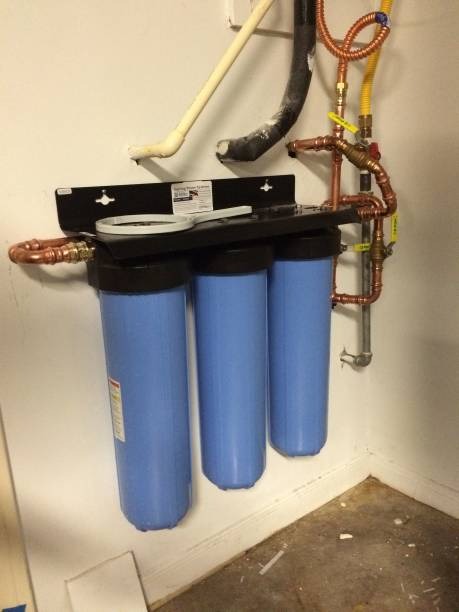Water Softener Installation in Queen Creek, AZ
Installing a water softener is one of the most effective long-term investments a Queen Creek home can make. With naturally hard groundwater across the East Valley, untreated water causes scale buildup in pipes, reduces appliance efficiency, and increases soap and detergent use.

Why a water softener matters in Queen Creek, AZ
Queen Creek homes frequently experience hard water minerals like calcium and magnesium. In Arizona’s hot, mineral-rich groundwater, scale forms faster inside water heaters, dishwashers, and plumbing fixtures. A properly sized and installed water softener:
- Protects plumbing and extends appliance life
- Restores soap and detergent performance
- Reduces scale on faucets, fixtures, and tile
- Improves water feel for skin and hair
- Can improve energy efficiency by keeping heat transfer surfaces clean
Common water softener issues in Queen Creek
Understanding common problems helps you choose the right system and avoid surprises:
- Salt bridging or crusting in the brine tank leading to no regeneration
- Resin fouling from iron, chloramines, or organic matter
- Control valve or meter failures that stop regeneration
- Under-sized systems causing frequent regeneration or softener bypass
- Improper placement causing drainage or venting problems
Step 1 — Hardness testing and diagnostic assessment
The installation process begins with accurate water testing. Hardness testing in Queen Creek typically uses:
- Titration kits or digital hardness meters for precise grains per gallon (gpg)
- Iron, pH, and total dissolved solids checks to identify additional pretreatment needs
- Flow rate assessment to size the softener properly based on peak household demand
Testing defines the target softening capacity and whether pretreatment (iron filters, sediment filters, or chloramine removal) is required before the softener.
Step 2 — System selection: capacity and technology
Choosing the right system balances capacity, regeneration frequency, and technology.
- Capacity: Softener size is expressed in grains removed before regeneration. We size systems based on household size, measured hardness, and daily water usage to minimize regenerations while ensuring continuous soft water.
- Salt-based ion exchange: The industry standard for reliable softening. Best when high hardness or iron is present and when guaranteed soft water is required.
- Salt-free alternatives: Conditioners reduce scale formation but do not remove hardness minerals. They fit households seeking lower maintenance or where salt discharge is a concern.
- Single tank vs twin-tank systems: Twin-tank (alternating) systems provide continuous soft water during regeneration and are recommended for larger homes or critical uses.
Step 3 — Site assessment and preparation
A thorough site assessment ensures a smooth installation:
- Identify an indoor location near the main water supply, drain, and electrical outlet, typically in a garage, utility room, or basement area
- Confirm proper drainage for brine discharge and access for salt delivery
- Check freeze risk, direct sunlight exposure, and clearance for service
- Verify local utility or HOA restrictions related to water-softening systems and brine discharge
Professional installation steps
A professional install typically follows these steps:
- Shut off and drain incoming water supply to the installation area
- Install bypass valve and plumb softener into the main line using proper fittings and unions for future servicing
- Connect drain line with air gap or approved drain methods
- Set up brine tank, add manufacturer-recommended salt, and sanitize new resin when applicable
- Program control head for initial regeneration type and time-of-day settings or enable demand-initiated regeneration
- Perform a test run, measure treated water hardness at a tap, and demonstrate the system controls
Typical install time varies with site complexity but often completes in a single day for standard residential installs.
Regeneration cycles and maintenance
Understanding regeneration and routine care keeps your system reliable:
- Regeneration types: Time-clock (scheduled) or demand-initiated (metered). Metered systems regenerate only when capacity is used and are more water- and salt-efficient.
- Salt management: Use high-purity softening salt (pellets or crystals). Check salt level monthly at first; typical refill intervals depend on system size and household usage.
- Annual service: Inspect control valve, clean brine tank, check for salt bridging, and test resin performance. If iron or chlorine fouling exists, periodic resin cleaning or pretreatment may be recommended.
- Common troubleshooting: If you see hard water after install, check bypass valve position, salt level, salt bridges, and regeneration settings before considering more complex issues.
Expected lifespan and common repairs
- Resin life: With proper maintenance, ion-exchange resin typically lasts 10 to 15 years; heavy iron or chlorinated water can shorten that lifespan.
- Control valves and electronics: Often offer replaceable parts and may need service or replacement over time.
- Typical repairs: Brine valve replacement, control head service, resin replacement, and leak repairs. Regular maintenance reduces unplanned repairs and extends useful life.
Warranty and financing considerations
New systems usually come with:
- Manufacturer warranty on tanks, control heads, and resin for varying durations
- Labor warranties that cover installation workmanship for a set period
- Financing options: Many homeowners use low-interest financing or payment plans to spread installation costs. When selecting financing, review warranty transfer conditions and service requirements to maintain coverage.
Local water-hardness considerations for Queen Creek households
Queen Creek and the greater East Valley are served by groundwater sources that commonly carry higher mineral content. Seasonal irrigation use, pool backwash practices, and municipal blending can affect hardness and iron levels over time. Given local climate - long, hot summers and high mineral content - the benefits of a properly sized water softener are amplified:
- Reduced scaling in hot water heaters helps preserve efficiency in high-use cooling months
- Softer water decreases spotting on outdoor glass, pool equipment, and irrigation emitters
- Pretreatment choices become more important in areas with elevated iron or sediment






